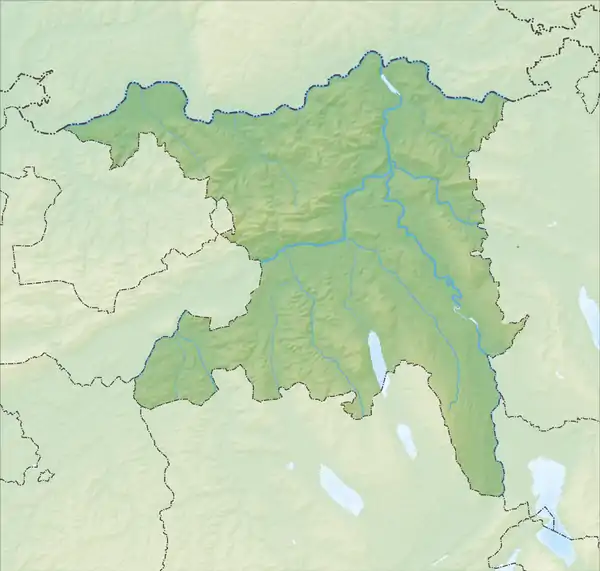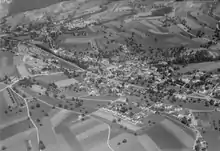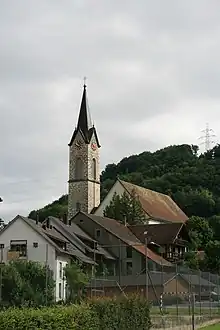Unterendingen | |
|---|---|
 | |
 Coat of arms | |
Location of Unterendingen | |
 Unterendingen  Unterendingen | |
| Coordinates: 47°33′N 8°18′E / 47.550°N 8.300°E | |
| Country | Switzerland |
| Canton | Aargau |
| District | Zurzach |
| Area | |
| • Total | 3.45 km2 (1.33 sq mi) |
| Elevation | 387 m (1,270 ft) |
| Population (2007) | |
| • Total | 350 |
| • Density | 100/km2 (260/sq mi) |
| Time zone | UTC+01:00 (Central European Time) |
| • Summer (DST) | UTC+02:00 (Central European Summer Time) |
| Postal code(s) | 5305 |
| SFOS number | 4321 |
| Surrounded by | Baldingen, Endingen, Lengnau, Tegerfelden, Würenlingen |
| Website | www SFSO statistics |
Unterendingen is a former municipality in the district of Zurzach in the canton of Aargau in Switzerland. On 1 January 2014 the former municipality of Unterendingen merged into the municipality of Endingen.[1]
Geography

Before the merger, Unterendingen had a total area of 3.5 km2 (1.4 sq mi).[2] Of this area, 1.85 km2 (0.71 sq mi) or 53.5% is used for agricultural purposes, while 1.31 km2 (0.51 sq mi) or 37.9% is forested. Of the rest of the land, 0.28 km2 (0.11 sq mi) or 8.1% is settled (buildings or roads), 0.01 km2 (2.5 acres) or 0.3% is either rivers or lakes.[3]
Of the built up area, housing and buildings made up 4.3% and transportation infrastructure made up 2.9%. Out of the forested land, 36.1% of the total land area is heavily forested and 1.7% is covered with orchards or small clusters of trees. Of the agricultural land, 45.1% is used for growing crops and 6.9% is pastures, while 1.4% is used for orchards or vine crops. All the water in the municipality is flowing water.[3]
Coat of arms
The blazon of the municipal coat of arms is Per fess Azure a Fleur-de-lis mediated Argent and Gules.[4]
Demographics
Unterendingen had a population (as of 2011) of 364.[2] As of 2008, 44.7% of the population are foreign nationals.[5] Over the last 10 years (1997–2007) the population has changed at a rate of -5.4%. Most of the population (as of 2000) speaks German(94.9%), with Serbo-Croatian being second most common ( 1.9%) and French being third ( 0.5%).[2]
As of 2008, the gender distribution of the population was 51.9% male and 48.1% female. The population was made up of 171 Swiss men (46.5% of the population), and 20 (5.4%) non-Swiss men. There were 164 Swiss women (44.6%), and 13 (3.5%) non-Swiss women.[5] In 2008 there were 2 live births to Swiss citizens and in same time span there was 1 death of a Swiss citizen. Ignoring immigration and emigration, the population of Swiss citizens increased by 1 while the foreign population remained the same. There was 1 Swiss man, and 3 non-Swiss men who emigrated from Switzerland to another country. The total Swiss population change in 2008 (from all sources) was an increase of 15 and the non-Swiss population change was a decrease of 0 people. This represents a population growth rate of 4.2%.[5]
The age distribution, as of 2008, in Unterendingen is; 28 children or 7.6% of the population are between 0 and 9 years old and 66 teenagers or 17.9% are between 10 and 19. Of the adult population, 52 people or 14.1% of the population are between 20 and 29 years old. 31 people or 8.4% are between 30 and 39, 64 people or 17.3% are between 40 and 49, and 69 people or 18.7% are between 50 and 59. The senior population distribution is 35 people or 9.5% of the population are between 60 and 69 years old, 15 people or 4.1% are between 70 and 79, there are 9 people or 2.4% who are between 80 and 89.[6]
As of 2000, there were 8 homes with 1 or 2 persons in the household, 43 homes with 3 or 4 persons in the household, and 70 homes with 5 or more persons in the household.[7] As of 2000, there were 132 private households (homes and apartments) in the municipality, and an average of 2.8 persons per household.[2] In 2008 there were 85 single family homes (or 58.6% of the total) out of a total of 145 homes and apartments.[8] There was a total of 1 empty apartment for a 0.7% vacancy rate.[8] As of 2007, the construction rate of new housing units was 19.8 new units per 1000 residents.[2]
In the 2007 federal election the most popular party was the SVP which received 30.5% of the vote. The next three most popular parties were the CVP (28.06%), the SP (15.25%) and the FDP (12.98%). In the federal election, a total of 123 votes were cast, and the voter turnout was 47.3%.[9]
The historical population is given in the following table:[6]
| Year | Pop. | ±% |
|---|---|---|
| 1975 | 127 | — |
| 1980 | 195 | +53.5% |
| 1990 | 329 | +68.7% |
| 2000 | 375 | +14.0% |
Sights
The entire village of Unterendingen is designated as part of the Inventory of Swiss Heritage Sites.[10]
Economy
As of 2007, Unterendingen had an unemployment rate of 0.72%. As of 2005, there were 15 people employed in the primary economic sector and about 6 businesses involved in this sector. 15 people are employed in the secondary sector and there are 5 businesses in this sector. 28 people are employed in the tertiary sector, with 11 businesses in this sector.[2]
In 2000 there were 198 workers who lived in the municipality. Of these, 158 or about 79.8% of the residents worked outside Unterendingen while 35 people commuted into the municipality for work. There were a total of 75 jobs (of at least 6 hours per week) in the municipality.[11] Of the working population, 15.2% used public transportation to get to work, and 60.3% used a private car.[2]
Religion

From the 2000 census, 186 or 50.1% were Roman Catholic, while 128 or 34.5% belonged to the Swiss Reformed Church. Of the rest of the population, there were 2 individuals (or about 0.54% of the population) who belonged to the Christian Catholic faith.[7]
Education
In Unterendingen about 89% of the population (between age 25-64) have completed either non-mandatory upper secondary education or additional higher education (either university or a Fachhochschule).[2] Of the school age population (in the 2008/2009 school year), there are 39 students attending primary school in the municipality.[7]
References
- ↑ Nomenklaturen – Amtliches Gemeindeverzeichnis der Schweiz Archived 2015-11-13 at the Wayback Machine (in German) accessed 13 December 2014
- 1 2 3 4 5 6 7 8 Swiss Federal Statistical Office accessed 9 January 2014
- 1 2 Swiss Federal Statistical Office-Land Use Statistics 2009 data (in German) accessed 25 March 2010
- ↑ Flags of the World.com accessed 23-June-2010
- 1 2 3 Swiss Federal Statistical Office - Superweb database - Gemeinde Statistics 1981-2008 (in German) accessed 19 June 2010
- 1 2 Statistical Department of Canton Aargau -Bevölkerungsdaten für den Kanton Aargau und die Gemeinden (Archiv) (in German) accessed 20 January 2010
- 1 2 3 Statistical Department of Canton Aargau - Aargauer Zahlen 2009 (in German) accessed 20 January 2010
- 1 2 Statistical Department of Canton Aargau (in German) accessed 20 January 2010
- ↑ Swiss Federal Statistical Office, Nationalratswahlen 2007: Stärke der Parteien und Wahlbeteiligung, nach Gemeinden/Bezirk/Canton (in German) accessed 28 May 2010
- ↑ ISOS site accessed 23-June-2010
- ↑ Statistical Department of Canton Aargau-Bereich 11 Verkehr und Nachrichtenwesen (in German) accessed 21 January 2010